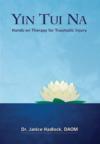SEARCH / BROWSE
Yin Tui Na: Hands-On Therapy for Traumatic Injury
WALTON-HADLOCK Janice [Other titles by this author]
ISBN: 9780997978315
Raja Books 0
AU $49.95
In Stock

Yin Tui Na teaches exactly how to perform the extremely light-touch manual therapy that can gently bring a patients’ attention to a long-forgotten or dissociated injury. This book is packed with photos showing how to hold various injured body parts, together with precise instruction in just how much pressure to use, where, and for how long.
Many acupuncturists receive an introduction to Yang Tui Na (overt, large, physical therapeutic moves) while studying Chinese medicine. The Yin techniques are rarely taught in schools.
The Yin Tui Na techniques are hands-on therapies that are subtle, even invisible to the naked eye, and based on releasing old holding patterns and tension.
Yin techniques are classically indicated for injuries at are “old, painless, or forgotten.”
This book includes instruction on Forceless, Spontaneous Release technique (FSR), the technique used by the Parkinson’s Treatment Research Team (1999 to 2013) for treating the unhealed injuries of people with Parkinson’s, as well as an introduction to light-touch craniosacral therapy and other light touch techniques.
The book also includes Qi Gong techniques that people who have dissociated from injuries can do to accelerate their responses to Yin Tui Na.
The appendices in this book teach how to determine if a person with Parkinson’s has merely dissociated from injuries – usually in childhood – that have eventually set his Parkinson’s in motion, and is therefore a good candidate for Yin Tui Na therapy
or if he has created a mental posture – also usually in childhood – that allows him to “rise above” or “be numb to” physical and emotional pain. In the latter case, the person with Parkinson’s will not yet want to receive Yin Tui Na treatment. He will instead want first to read the material in Stuck on Pause,
Preview from inside the book
“A traumatic injury from which a person has dissociated will not fully heal. Only when the injured person can bring himself to fully acknowledge the injury and its accompanying pain, will the injury be able to heal completely. The most effective treatment for such injuries is often firm, manual support that is non-invasive and non-manipulative: Yin Tui Na
The first technique discussed in this book, Forceless, Spontaneous Release, or FSR, instructs in a certain tempo of treatment (slow), amount of pressure applied with one’s hands (firm), and a lack of intention that the practitioner brings to the treatment. The physical and emotional support provided by this technique can bring a patient’s attention to an injured area so that healing can begin. FSR can be performed almost anywhere on the body that has unhealed injuries. In people with Parkinson’s, the legs, feet, and ankles are areas that nearly always call out for treatment. This technique does not apply particular vectors, directions of movement, to the patient. However, corrective movement in twisted or displaced tissues often occurs, spontaneously, as the patient responds to the firm support. This technique can also be used diagnostically, to detect injuries and holding patterns.
The second technique discussed uses very gentle nudges to suggest directional movements in muscles that have become stuck in a particular holding pattern. The examples of this technique included in this book show applications for the rotational joints of the hips and shoulders, but this technique of gentle nudges can be used in almost any body part that has become locked up. This particular technique does not have a name. It uses the tempo and support principles of FSR, but has intentional movement.
(For this item please quote stock ID 48328)
Related Subject Areas:
